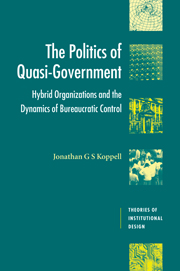Book contents
- Frontmatter
- Contents
- List of figures
- List of tables
- Acknowledgments
- List of acronyms
- 1 Introduction
- 2 Building a better model of bureaucratic control
- 3 Administration by regulation
- 4 Principal's preference, organizational structure and the likelihood of control
- 5 Hybrid organizations and the alignment of interests
- 6 The limits of congressional control: agent structure as constraint
- 7 Regulating hybrids: structure and control
- 8 Conclusion
- Appendix: background of organizations studied
- Interview subjects
- References
- Index
3 - Administration by regulation
Published online by Cambridge University Press: 22 September 2009
- Frontmatter
- Contents
- List of figures
- List of tables
- Acknowledgments
- List of acronyms
- 1 Introduction
- 2 Building a better model of bureaucratic control
- 3 Administration by regulation
- 4 Principal's preference, organizational structure and the likelihood of control
- 5 Hybrid organizations and the alignment of interests
- 6 The limits of congressional control: agent structure as constraint
- 7 Regulating hybrids: structure and control
- 8 Conclusion
- Appendix: background of organizations studied
- Interview subjects
- References
- Index
Summary
Principals rely upon a variety of tools to control their bureaucratic agents. Many hybrid organizations are differentiable from traditional government agencies by the set of tools available to principals seeking control. For example, Congress cannot use the annual appropriations process to compel government-sponsored enterprises to satisfy their preferences because GSEs are not included in the federal budget. Still, GSEs are subject to governmental regulation. This provides Congress opportunities for indirect influence through oversight of the GSEs' regulators.
Examining the consequences of such structural “substitution” is a logical starting point for a study of quasi-government. It is the elimination of traditional control mechanisms that arouses concerns of lost control when public policy responsibilities are delegated to hybrid organizations (Musolf and Seidman 1980).
In this chapter, two sets of control tools are differentiated, one associated with traditional government agencies and one associated with hybrid organizations. Principals attempt to control traditional agencies with what are here characterized as “administrative control tools.” This includes the entire range of laws, structures, practices and conventions associated with the principal-agent relationships of US government agencies. This definition is elaborated below.
Principals seeking control of hybrid organizations, in contrast, must rely upon a reduced set of administrative control tools or an entirely different set of tools that are here referred to as “regulatory control tools.” This phrase is intended to capture a heterogeneous set of institutional relationships between hybrids and their principals. It includes regulations, rules, contracts and procedural requirements. This too is specified below.
- Type
- Chapter
- Information
- The Politics of Quasi-GovernmentHybrid Organizations and the Dynamics of Bureaucratic Control, pp. 37 - 69Publisher: Cambridge University PressPrint publication year: 2003

